
Original Link: https://www.anandtech.com/show/2706
CES 2009 - TV Trends, WirelessHD, 240Hz and Netbook Pricing
by Anand Lal Shimpi & Manveer Wasson on January 12, 2009 12:00 AM EST- Posted in
- Trade Shows
While PC/Consumer Electronics convergence has undeniably happened, CES is still a consumer electronics show. Our first press conference of the show was with ASUS talking about netbooks, but the next day was full of mostly TV makers discussing their 2009 lineups.
Generally the focus of most TV manufacturers at CES is to talk about how cool their TVs look and go rather light on the technology. This year, as we mentioned in our earlier coverage, we got more meat for our minute - we rarely heard about 100”+ TVs and instead got a real dose of technology.
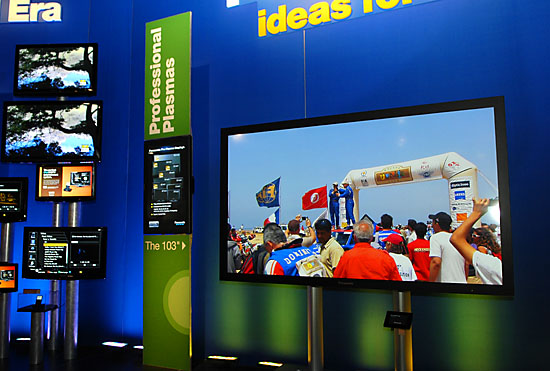
Large TVs were in Vegas this year, they just weren't the focus of the show. Photography by Laura Johnston.
So forgive me while I talk about a less PC, but very technology oriented element of this year’s CES: LCD TVs.
Wireless Inputs are In
I already mentioned that last year’s CES was very much a displays show. Nearly every manufacturer either had a focus on having the thinnest TVs or the largest screen size. As with most pissing contests, at the end of it you tend to feel a bit silly; so this year we saw less glam and more functional features.
Here’s the problem. LCD and Plasma TVs are dropping in prices. While that alone isn’t a problem, with more consumers purchasing them you have more people trying to wall mount their new flat screen TV. The issue with wall mounting is that most TVs are useless by themselves; you need an input source of some sort. Whether it’s a cable box, HTPC or Blu-ray player, getting your content to the TV usually means running cables from one or more boxes to your TV.
This tends to make wall mounting your brand new TV far messier. While the TV looks like a part of the room, the sources dangling from it don’t. Last year a couple of companies showed TVs with wireless inputs. There’s a separate box that communicates wirelessly to the TV, and you plug all of your sources into that box.
This year, wireless inputs are in and far more companies had demonstrations of TVs with wireless inputs.
The standard is WirelessHD. Your inputs are connected wirelessly to the TV via a 60GHz signal, capable of transmitting full bandwidth 1080p60 at a distance of up to 30 feet. The transmission is lossless and is sent uncompressed. The same goes for audio, you can send up to 7.1 audio wirelessly between the box and the TV.
Samsung, Panasonic and LG all had TVs at the show with wireless inputs, all using the same WirelessHD standard.
Eventually I’d expect to see wireless outputs directly on CE devices and wireless inputs on TVs, cutting out the set top box middleman. I suspect that’ll be a while given how many legacy devices users will want to connect to their TVs.
More TV Trends: Thin, Local Dimming and 240Hz
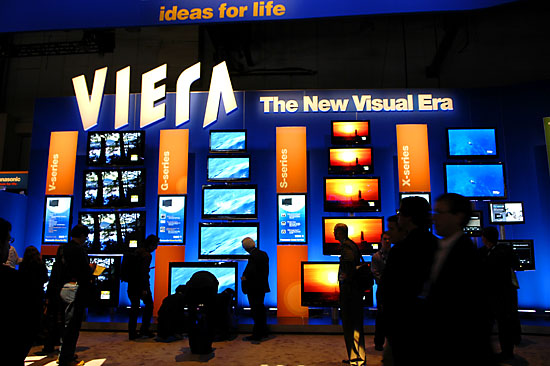
Panasonic demonstrated a 1” thick plasma display as well as a prototype 1/3” plasma at this year’s CES.
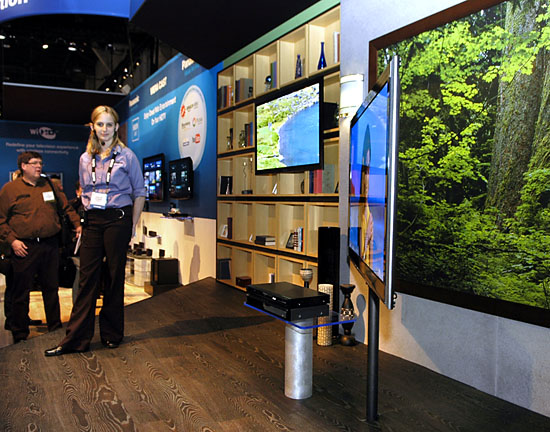
Thin is in. WirelessHD should eventually help reduce the thickness of TVs as well.
We also saw a brightness and power consumption demo similar to what was shown off last year. In short, brightness per watt is improving with newer panels over older ones. If you have a plasma or LCD that’s only 3 or 4 years old, you’ll most likely see a huge improvement either in brightness or power consumption (or both) by moving to a newer panel.
The LCD vs. Plasma debate basically boils down to this: LCDs have brighter whites and plasmas have deeper blacks (there’s also the glare issue but let’s ignore that for now). Given the lower cost of LCD panels at smaller, more mainstream sizes, TV makers are often looking for ways to improve black levels without sacrificing white levels.
If you could control the backlight of individual areas of the panel, you could turn it off completely in dark areas and leave it on in white areas. The concept and technology has been around for a while, but what we needed was rear-lit LED backlighting to make it affordable.
Instead of the panel being lit from the sides, with a rear-lit (or full matrix) backlight it’s illuminated from behind using many LEDs. With a true backlight composed of many LEDs it’s easy to dynamically turn on/off groups of them depending on the scene. The result is better black levels without sacrificing the bright whites that make LCDs so desirable. We saw similar technologies demonstrated last year in the Panasonic and Pioneer plasmas at CES 2008.
Another potential benefit of full matrix LED backlighting is what Toshiba and some other manufacturers are calling the 240Hz effect. Last year we saw the beginnings of a move to 120Hz LCDs, which you may remember isn’t LCD panels with 120Hz refresh rates. There are only 60 frames of data displayed, the data in between two frames is simply interpolated on the fly effectively giving you 120 frames per second (but from only 60 frames worth of data).
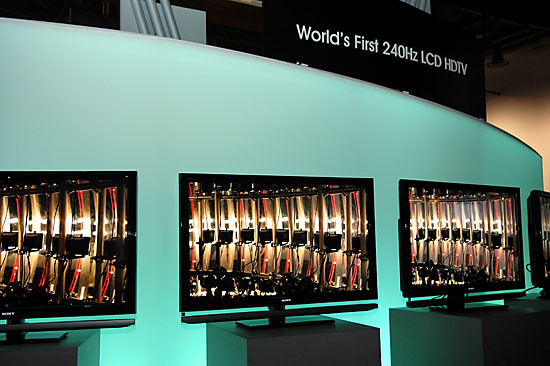
The 240Hz panels don’t interpolate a second time, instead some use a technique called backlight scanning. You still perform the same 120Hz effect but you turn portions of the backlight on and off very quickly to make for 240 different frames per second. Sets that support 240Hz in this manner obviously can also support local dimming, but it’s unclear if they can do both at the same time.
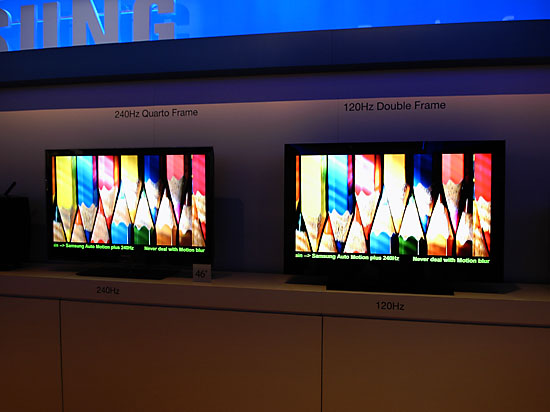
Samsung uses interpolation on its 240Hz TVs
Some manufacturers are interpolating a second time, so you get one original frame and 3 interpolated frames, at a rate of 240Hz without doing any backlight trickery. On paper this sounds like a better implementation however the displays that use additional interpolation also lack local dimming. Both Samsung and Sony generate 240 frames using interpolation and both companies use edge-lit LED backlights. Interestingly enough, Samsung used a rear-lit LED backlight in last year’s model with local dimming support and moved away from it this year.
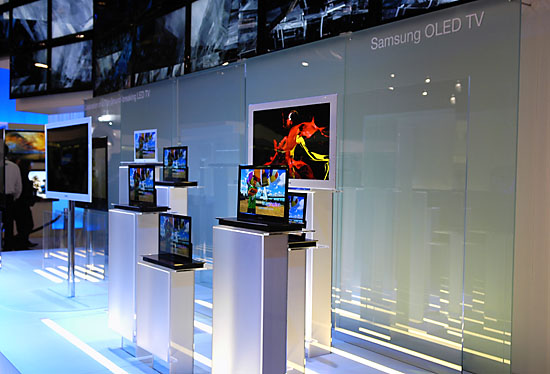
OLED TVs were at CES, but still not ready for mainstream consumption yet
Internet Enabled TVs
We saw streaming internet content in CE products in early forms at last year’s CES. This year, companies have forged partnerships with the likes of Netflix, YouTube, and Yahoo in order to provide content directly to TVs and Blu-Ray players. Unfortunately, each CE company has forged alliances with different content providers. So while Sony can provide you with YouTube and Amazon Video streaming, it will not provide streaming HD Netflix movies like LG and Samsung can.
Although the idea of not needing to hook up a PC to your TV to view your favorite YouTube videos is nice, locking content providers to specific CE companies certainly hinders its usefulness. Streaming content is probably not a deal breaker for most consumers’ CE purchases.
Toshiba Talks the Future of TVs
Toshiba was big on talking about the future of its LCD TVs at this year’s CES so we got a big tech demo of what’s to come.
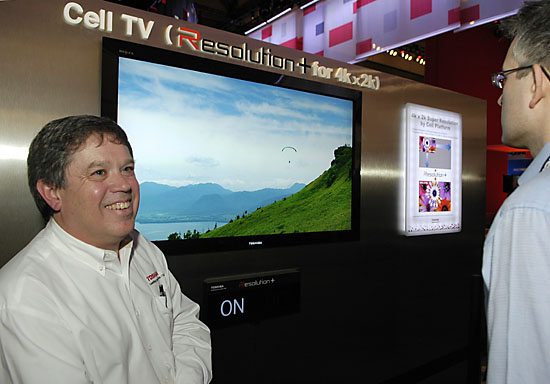
Tosh was the only manufacturer to say that 4K x 2K panels will be the future of LCD TVs, the rest were far more focused on today’s 1080p displays. The name is a bit misleading as the actual panel resolution is 3840 x 2160 (or 2 * 1920 x 2 * 1080). Since it’s an even multiple of 1080p, upscaling 1080p content to a 4K panel isn’t difficult - so existing content should adapt well to it. While 4K displays are still a while away, as soon as there’s content to support it, we’ll start seeing them.
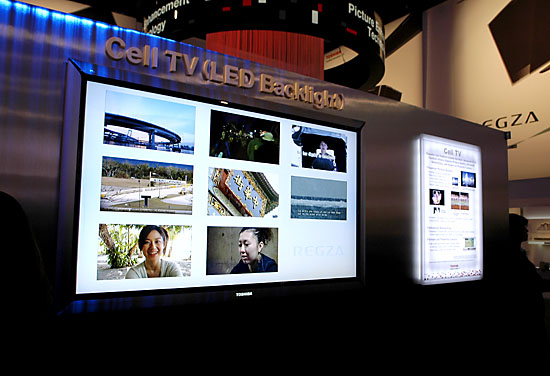
The 4K demo was done on Toshiba’s Cell powered TV. The Cell TV is powered by the same Cell processor that’s in Sony’s PlayStation 3, the difference being that here its used to drive the menu system and handles all upscaling of lower resolution content to the 4K panel. Additionally, the Cell processor runs the backlight dimming algorithm. The advantage here being that Cell is powerful enough to control more dimming zones than the Regza lineup’s current processor.
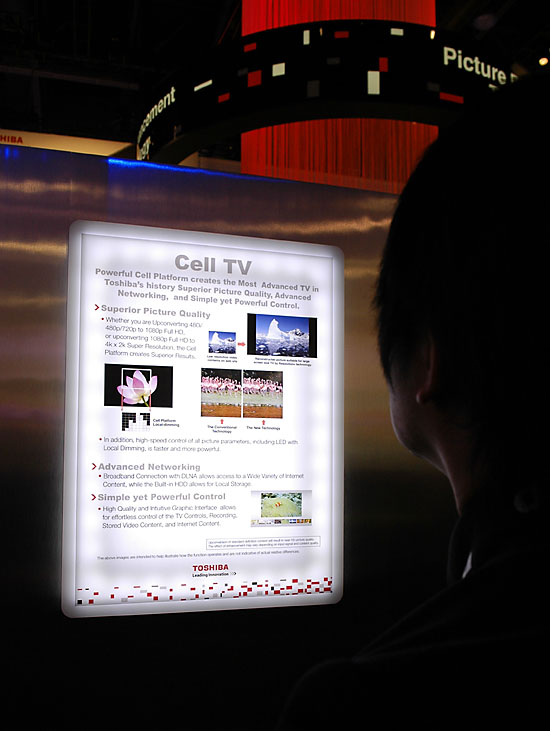
The Cell processor is also fast enough to decode 6 simultaneous HD streams at once. While you probably won’t watch six things at the same time, you could have a ridiculous picture in picture mode that’s very Back to the Future II-esque.
The rest of the technologies Toshiba talked about will be shipping on their 2009 model year Regza lineup.
Deep Lagoon is the name for Toshiba’s new bezel design. The idea is to make the panel and bezel seem as one. The bezel is black like the panel (but a more panel-like black) and is perforated as you get away from the panel to give it the appearance of fading away. The highest end Regza will have a bezel that is flush with the LCD panel.
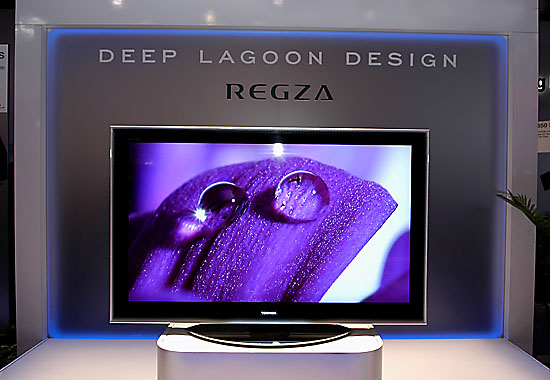
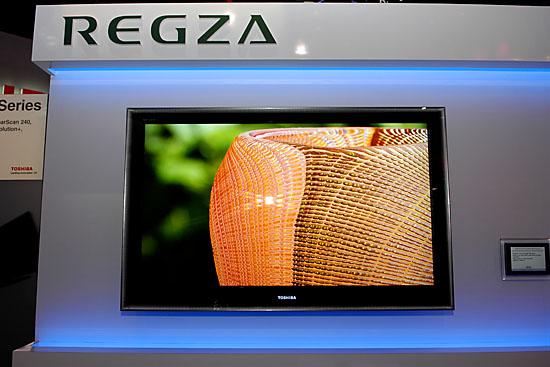
Toshiba’s TVs will also include a technology called Dolby Volume. A modern take on a solution to an old problem: how to deal with watching content with different volumes. You know the case, you’re watching a TV show at a particular volume and are interrupted by a commercial that’s far too loud.
TVs have shipped with adaptive volume for quite some time, but Toshiba argues that the old solution wasn’t good. The old solution used to be to simply apply a low pass filter that would eliminate high frequency audio. You’d get the impression of lower volumes but at the expense of actually losing some of the audio.
Dolby Volume keeps all of the audio; it simply compresses the spectrum. Louder sounds get quieter and quieter sounds get louder, allowing you to listen at low to normal volumes without worrying about blowing out your ears if an inconsiderate commercial airs.
As is the case with all spectrum-compressing technologies, audio purists may want to opt out. Most of these sorts of technologies in TVs (including overboosting colors) tend to appeal to the users who aren’t as in tune with (or don’t care about) what things are intended to look/sound like. It’s the same reason that distorting 16:9 stretch modes are so popular despite what they do to peoples’ faces. Dolby Volume appears to be a better solution to the volume problem, but unless you dynamically adjust the volume on your TV set, compressing the spectrum isn’t going to be the most acoustically pure solution.
Toshiba is including an Expert Mode on its 2009 LCD TVs. Although we didn’t get any additional information, it sounded like an easily accessible service menu, giving end users the same access that a calibrator would have without the risk associated with modifying settings in the service menu. We’d hope that more TV manufacturers would expose service-menu settings in a safer environment for the enthusiast market.
Toshiba talked about a feature called Instaport. When you turn the TV on it will perform the HDCP handshaking with all HDMI devices that are connected and turned on, so that switching between the HDMI inputs on the TV is faster. Toshiba didn’t demo the technology and it’s only useful if you have a bunch of devices turned on all the time, but it’s an attempt at addressing an annoying problem with current TVs.
Another Toshiba-only tech topic was 14-bit color processing on its Regza TVs. The LCD themselves don’t use 14-bit panels, but all processing is done internally with 14-bit resolution and then downsampled upon output. There are situations where 14-bit internal precision could help reduce color banding but I’m guessing that more often than not you won’t notice a difference.
Ridiculous Netbook Pricing
Thanks for listening to me talk about TVs for a while, now let’s move on to more PC-topics. In particular, I’d like to address the ridiculous nature of netbook pricing.
I had the pleasure of dining with Intel’s Mooly Eden at CES. You may remember Mooly as the father of Centrino; he headed up the Banias design team, which was responsible for the very first Centrino CPU. These days Mooly is more marketing than engineering, but he hasn’t lost his ability to be frank.
I talked to Mooly about how the Atom processor wasn’t delivering enough performance for the netbooks that it’s in. I asked him what happens once Moorestown comes around; will Atom continue to be the netbook CPU of choice or will Intel introduce a very scaled down Nehalem for netbooks and use Atom in smartphones and other smaller devices?
To my surprise, Mooly said that the Atom delivered fine performance for netbooks. But it turned out that Mooly and I had very differing views on netbooks. Mooly’s view was that netbooks should be ultra affordable devices priced between $299 and $349. At those prices, Atom does deliver enough performance.
The reality of the situation however, is that manufacturers are shipping netbooks in the $500 - $900 range (way to go Sony) and outfitting them with 1.6GHz and even 1.33GHz Atom processors. I get that you’re paying a premium for the size of the device, but it seems to me that manufacturers are capitalizing on the newness of netbooks by attempting to price them much higher than they should be.
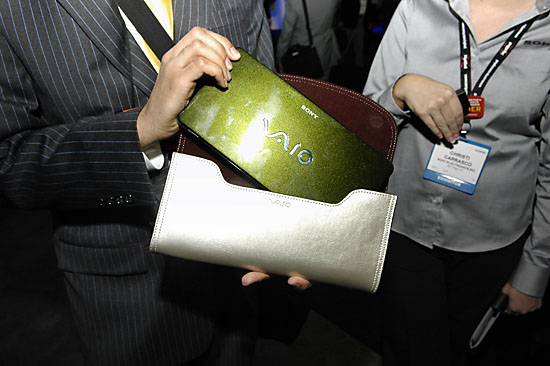
Stylish, it'll fit in your purse, but it's still got a CPU slower than what was in a mainstream notebook from 2004.
While Dell and HP should be commended on entering the market at or near that $299 - $349 range, I’d like to see more of that sort of behavior from their peers in the market. I think it’s very telling that Apple has opted out of building an Atom-based system thus far; the only reason it makes sense is if you price it very low, and that’s not something Apple would do. The alternative would be putting an Atom in a higher priced notebook, which would compromise the experience, something Apple is also not too keen on doing.













